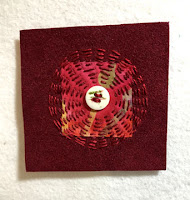Stitch Meditations have always brought me pleasure and a sense of grounding. I suppose it’s partly because I started hand stitching at an early age. I can get lost in stitching and hours go by so fast. I stopped doing the little daily stitches this year and have missed them. I still get on Facebook and see what others are doing but I’ve made very few myself this year.
Recently I made one and discovered how sorely I had missed
doing them daily. So, I’m trying to get back to a daily habit.
I stumbled upon some silver metallic looking fabric the
other day and bought some to try on a woven wreath I was wanting to make. It
came out great and so I made my way back to the store and bought some more of
the fabric. If you are into fabrics you know if there is a fabric that speaks
to you, you had better buy if while it’s available. Otherwise, when you go back
to get more it’s gone!
 |
| Woven Silver Wreath |
Since I had this fabric I was thinking of other ways to use it. What about the background for a Christmas card? That would look good. But what theme to put on it. My mind wandered to a fabric artist that I am intrigued by who makes wonderful art pieces with just scraps of fabric. I remembered she had made some poinsettias. Maybe I could do something like that. I snipped some pieces of green and red fabrics and arranged them to resemble the poinsettia. Then I stitched them down. I decided to add a yellow button for the center using red thread in sort of a star pattern.
 |
| Poinsettia from fabric snippets |
Then I thought I’d try a more detailed one by cutting the leaves and brackets out rather than just snipping little pieces of fabric. I cut out a leaf freehanded. I like it so that became my pattern for the leaves. For the red bracts I just cut pieces out from three different types of red fabric and laid them down. After using a little bit of glue to hold them in place I stitched them to the background fabric. For the center I decided to do French Knots in red, yellow, and white.
 |
| Poinsettia with French Knots |
Happy with those two I thought what if I do a more minimal, modern, abstract one. Now minimal is difficult for me. My favorite art instructor was always suggesting I remove some element from my work. Guess her suggestion has stuck with me as I try sometimes successfully, sometimes not so successful.
For the centers I had been wanting to use a shiny yellow
button I had but it was a shank type button and would not lay flat on the
piece. I knew if I placed it in the opening of a fabric yoyo that would make it
look a little better. I wanted to make a yoyo for the center of this one. I
know maybe not so modern after all. For the yoyo I wanted a fabric that would
resemble the center red, yellow, and white, I remembered I had some aloha
fabric that was red, yellow, and white. I knew I had quite a bit of it but
where was it in my stash. I looked in several places unsuccessfully. Frustrated
I prayed “Lord help me find that fabric. I just need a little bit of it.” Then
I remembered I had used some of it to make some flags to use as decorations for
a party for my Hawaiian husband. I knew right where some leftover flags were stashed.
And yes there were some from that fabric. I made my yoyo and put the button in
the middle.
 |
| Modern Abstract Poinsettia |
Happy with the outcome of all three. And I’m thinking of a fourth one from round circles.
Who knows maybe I’ll have a full quilt of little poinsettias
for Christmas next year.
Or maybe they will just grace Christmas cards.
Happy needle pulling thread!
Rose















